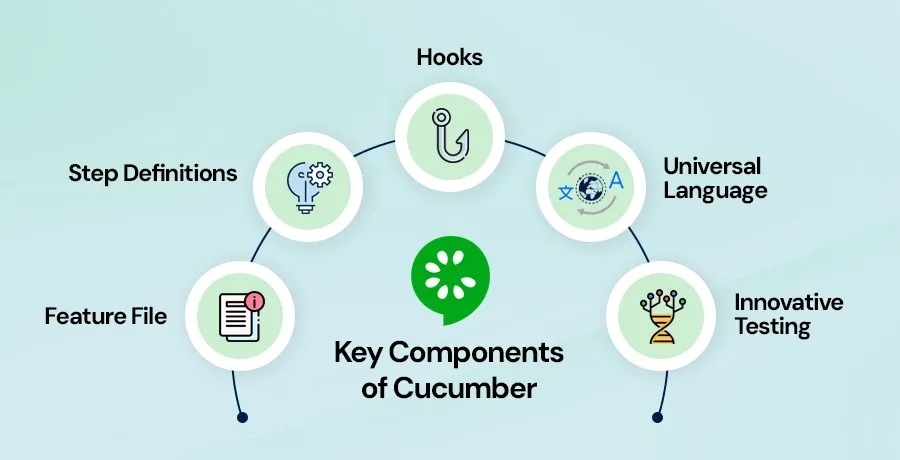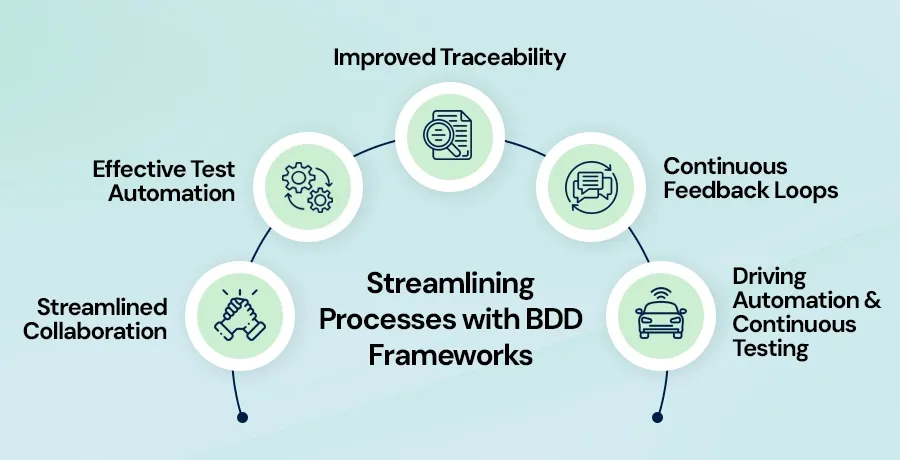
Behavior-Driven Development (BDD) frameworks are an easy approach to workflow optimization.
In this article, you're going to read about different frameworks like Cucumber, and JBehave that enable collaboration between developers, testers and business stakeholders, by explaining application behaviour in a common language. They perform automation testing processes to get the more efficient results.
It removes the gap between the technical and non-technical team members. It provides clarity and ensures that software meets the business requirements effectively. So let's begin the journey and understand about Behavior-Driven Development (BDD) in depth.
What is Behavior-Driven Development?
Behaviour-driven development, or BDD, is a testing framework set and practice designed to reduce wasteful behaviour in software development. Automated tests are a byproduct of the process that drives implementation.
BDD is a branch of principle defined by Test-Driven development. In the TDD, we build things right and accurately, while in the BDD, we ensure that we build the right thing. BDD is rarely a new concept in 2021.
Most Companies, ventures, or organizations adopt the BDD as an efficient and easy way to convert Business Requirements into Good Software using the BDD Framework or Tools. BDD testing frameworks can streamline the development process.
BDD Frameworks Understanding:
Behaviour-driven development, or BDD testing frameworks such as Cucumber, Junit, Spec Flow, and Behave, Provide a Well-structured approach to writing automated tests that directly correspond to the desired behaviour of the software.
These frameworks allow the developer or testers To write the test scenario in the natural language format using the Given, When, And & Then syntax.
Below is an example of the syntax and the scenario of a simple login module. This kind of syntax is helpful for normal people or stakeholders who are not very technical, and it's very simple to go through the test scenario and easily identify.
Scenario: Verify the Login Functionality for Feature File.
- Given the precondition,
- When the action is followed,
- Then result
These features or behaviours are mapped to the test code that can execute and validate the behaviour.
Cucumber is a Behavior-Driven Development Tool or BDD:
Cucumber uses the Gherkin Language to Define the test cases. It's a nontechnical Language that is easy to read and understand the detailed explanation of the scenario along with its syntax, as shown in the above example.
Key Components of Cucumber
Feature File:
Step Definitions:
Step Definitions is an act or serves as the Bridge between the Feature files and Automation code.
The Step Definitions provide the instruction for Cucumber to execute the code as written in the feature file & it executes line-wise as the line encounters the codes belonging to that line are going to execute.
Step Definitions enable translating human-readable scenarios or use cases into executable test scripts.
Hooks:
Hooks are allowed in the Cucumber, which executes setup and teardown operations before and after scenarios.
Hooks provide flexibility in test execution and enable teams to configure the testing environment as needed.
Universal Language:
BDD frameworks promote the usage of a universal language spoken by all parties involved in the project.
When discussing requirements and features, this widely used language guarantees that all project participants speak the same language and promotes successful communication.
Innovative Testing:
Throughout the testing process, Behavior-Driven Development or BDD promotes cooperation between developers, testers, and business stakeholders. BDD frameworks guarantee that requirements are precisely captured and validated from the beginning by including stakeholders in the development and review of feature files.
Streamlining Processes with BDD Frameworks:
Teams that adopt BDD frameworks can improve their workflows in several ways.
Streamlined Collaboration:
BDD promotes cross-functional cooperation by including stakeholders in developing and evaluating feature files.
By working together, needs are precisely identified and verified, resulting in a mutual comprehension of the objectives and priorities of the project.
Effective Test Automation:
BDD frameworks enable teams to conduct tests fast and reliably by automating the validation of system behaviour.
Through automation, testing is completed more quickly, with less manual labour and more resources available to concentrate on other important duties.
Improved Traceability:
BDD frameworks offer a traceable relationship between the implementation code, tests, and requirements.
Teams may track changes effects and ensure requirements are implemented appropriately by tying feature files to automated tests and source code.
Continuous Feedback Loops:
BDD encourages continuous feedback loops throughout the development lifecycle. Teams may find problems earlier, iterate faster, and produce higher-quality software with more assurance when requirements are validated frequently.
Driving Automation and Continuous Testing:
Cucumber's integration with automation frameworks, such as Selenium and Appium, enables the teams to automate acceptance tests based on the behaviour specifications outlined in the feature file.
This automation process accelerates the testing stuff, allowing for rapid feedback in terms of the quality of the software.
Furthermore, Cucumber's support for continuous integration tools, such as Jenkins and Travis CI, enables fluent and seamless integration of automated tests into the development workflow, promoting a culture of continuous testing and delivery with Quality Management.
Important Elements of Continuous Testing:
Shift-Left Testing:
Continuous testing focuses on testing frequently and early in the development process, moving testing tasks to the left to find and fix issues earlier.
Integration with CI/CD Pipelines:
To guarantee that tests are run, continuous testing is smoothly integrated into CI/CD (continuous integration/continuous deployment) pipelines.
Software development can be made more innovative, dependable, and efficient by combining automation and continuous testing.
Accelerated Delivery:
Teams may produce high-quality software more quickly without compromising reliability when they use automation to conduct tests quickly and continuously.
Early Defect Detection:
Continuous testing lowers the chance of late-stage defects and production failures by detecting errors early in development when they are less expensive and time-consuming to resolve.
See Also: Complete Guide To Scale Your Business With Odoo
Conclusion:
BDD frameworks Provide a powerful framework for Streamlining the software development lifecycle, from the initial requirements gathering to the final delivery of the software or product.
By Adopting collaboration, automation, and alignment with business objectives, BDD frameworks empower teams to deliver high-quality software that meets user expectations.
By enhancing the BDD principles, teams can optimize their workflows & enhance communication. Overall, BDD is a great Framework or tool that helps develop & integrate the right thing the right way.
Build Your Custom Software Without Limitations.


